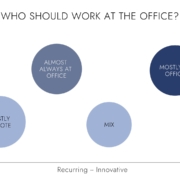Trust: The Single Most Important Thing You Need To Know About it
Trust intersects three factors: reciprocity, competence, and reliability. Reciprocity means the relationship is a two-way street: both parties are better off.
The single most important thing you need to know about trust is reciprocity, which will make or break your small business or solo practice.
Suppose you are like many small business CEOs and have frustrations with employee disengagement and turnover, lack of buy-in, and poor accountability. In that case, you probably have a low-trust workplace that’s damaging your profitability, sustainability, and peace of mind.
“Compared with people at low-trust companies,” a study in Harvard Business Review reports, “people at high-trust companies report: 74% less stress, 106% more energy at work, 50% higher productivity, 13% fewer sick days, 76% more engagement, 29% more satisfaction with their lives, 40% less burnout.”

How would you feel having fifty percent higher productivity, lower absenteeism, and tremendous energy?
For solo practitioners, common objections from your prospects, such as lack of time, money, or need, are reflections of a trust deficit. Your prospective clients ask themselves, “do I feel safe, will the support be helpful, is the juice worth the squeeze?” Competence is the ability to do your job to the required standards, and reliability is that you will do what you say you will do.
Competence is the ability to do your job to the required standards, and reliability is that you will do what you say you will do.
You need all three in place to have a trusting relationship. Without reciprocity, you have one party taking advantage of the other. Lack of competence means underperformance, and poor reliability creates inconsistency.
The element most often missing in low-trust situations is reciprocity.
I spoke with a company executive who complained that she did not have the budget for leadership training and that the CEO wouldn’t reallocate any money.
She’s facing workplace burnout, employee turnover, and presentism — where people are (or appear to be) physically present but are unengaged and unproductive. Helping her direct reports become better leaders would alleviate these problems and allow her to focus on growth and innovation rather than getting stuck in failure work and dispute resolution.
These problems are costing the company millions.
She’s facing workplace burnout, employee turnover, and presentism — where people are (or appear to be) physically present but are unengaged and unproductive. Helping her direct reports become better leaders would alleviate these problems and allow her to focus on growth and innovation rather than getting stuck in failure work and dispute resolution.
These problems are costing the company millions.
The CEO makes $20 million annually; the next highest-paid person makes a fraction. He could reallocate .01 percent of his annual salary to develop key subordinates and see a 10:1 return on investment or higher payoff for the company.
The problem, of course, is that the CEO has little incentive to improve things. He’ll get a massive payout even if he’s fired for underperforming. Burnout, turnover, and presentism are symptoms of an overall lack of trust within the company.
The senior leaders are violating the gardener’s principle: the responsibility to provide the cultivation so that the best version of each person blooms.
Gardner’s till the soil and feed the plants to stimulate growth. They prune away anything preventing the plant from being its best self. They do not try to turn one vegetable into another.
When you cultivate your employees to become their best selves, they’ll respond by contributing their best to your company’s success.
The employees at this company, I’m told, see the vast discrepancies in salary and unwillingness to invest in them. The relationship seems one way.
The employees thus treat the company as a commodity — a bargaining chip to a better-paying job at a different company.
The gardener’s principle works for solo practitioners, too. When you show how you help your clients achieve their dreams and be the heroes of their own stories, they’ll drop the money, time, and need objections.
Solopreneurs:
There’s still time to register for Joyful Sales Conversations, where I’ll show you how to put the gardener’s principle into action. When you create trust, you will transform your business.
June 17th & 28th 11:00 – 11:30 am US Central (plus 30-minutes for Q&A afterward)
REGISTER HERE




